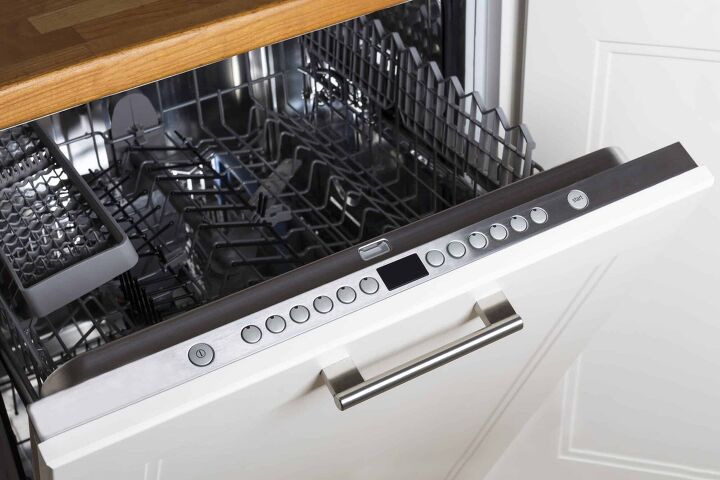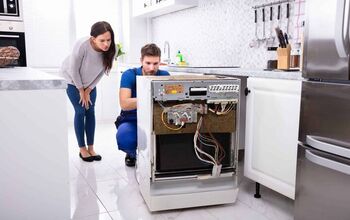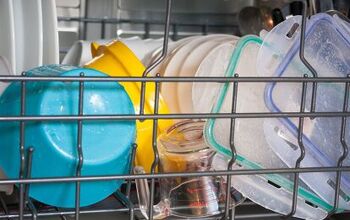Can You Plug a Dishwasher Into A Regular Outlet?

There are so many dishwashers on the market today that as a consumer, you now have many options when it comes to not only the size and type of machine, but also installation choices.
When you remove your old dishwasher, check to see how it getting it was getting its power before deciding on what method you would like to use.
Yes, you can plug a dishwasher into a regular outlet. However, the decision on whether a dishwasher is hardwired, or cord-and-plug connected depends solely on the installer. Due to the National Electrical Code, all outlets must be accessible. If you cannot find where the dishwasher is plugged in, then it’s likely hardwired.
Dishwashers do not typically come with power cords. This allows you the ability to connect it to the power source that was designated for your dishwasher.
If you are replacing a dishwasher you can look around the area where the old one was to see if it was hard-wired or a plug-in and follow suit.
Do You Need Appliance Installation or Replacement?
Get free, zero-commitment quotes from pro contractors near you.

Hardwiring
Hardwiring was very common for appliances, even appliances like the toaster used to be hardwired. This was because appliances were more often repaired than replaced and the need for there to be permanent electrical receptacles for them wasn’t as practical.
Nowadays, most new construction houses will have electrical outlets near dishwashers so that they are easier to uninstall and replace in case they break down.
The NEC has also specified that dishwashers must be GFCI protected, though that doesn’t differentiate between cord-and-cap or direct connection. Not all states have adopted this, so it’s important to check with your local electrical code.
If connecting using direct wiring you must use flexible, armored or nonmetallic sheathed copper wire with a grounding wire that meets the wiring requirements for local codes and ordinances.
Plug-In Dishwasher
A dishwasher runs on 120-volt power, so if your local electrical code allows it, you can use a plug to power your dishwasher. If you are going to plug in your dishwasher, it must have an appliance receptacle installed where it can be reached. You must be able to reach the outlet to unplug the dishwasher without having to move it.
Some states require an Appliance receptacle outlet, which has only one place to plug an appliance into. This cannot be shared with anything else, including the garbage disposal.
Other states allow you to plug both a dishwasher and garbage disposal into the same electrical outlet, granted the amperage is sufficient to handle the load, at a max of 80%.
Using a Dedicate Circuit for your Dishwasher
There are now many states adopting the NEC requirement that your dishwasher must be on its own dedicated circuit. This is a dedicated 120/125-volt, 15-amp circuit.
This circuit must also have a GFCI breaker on the circuit breaker panel. AFCI protection may not be required but that will depend on the local municipalities interpretation of the code. A dedicated circuit will give your dishwasher ample power without tripping the breaker if you are using other appliances.
Installing a Dishwasher
Step 1: Turn off the Water and Electric Supply
Turn off the water supply to the dishwasher by locating the hot water valve that should be located nearby, probably under the sink. It will look like an outdoor faucet and you will turn this in a clockwise direction until it stops.
Shut off the breaker that is providing electricity to the unit. To do this, toggle the switch at the electrical panel that is associated with the dishwasher circuit. Double-check that power is off before continuing, by trying to run the dishwasher.
Step 2: Prepare the Connections
It is a good idea to replace the water supply line unless the existing line is copper. This is to ensure a clean start in case you have any buildup within the line.
Secure the tubing tightly to the water line under the sink, making sure there are no kinks as it goes from the water line to the dishwasher. Run the new drain hose from the dishwasher cabinet to the area under the sink where the sink drain is.
Step 3: Connecting the Water Line to the Dishwasher
Move the dishwasher onto its back so that you can access the panel at the base of the unit. Wrap Teflon tape around the threads of the water inlet and connect the water line to your dishwasher.
Make sure this seal is tight to prevent any leaks. Otherwise, it is a big hassle to pull the dishwasher out in order to fix them.
Step 4: Connecting the Electrical Wires
Locate the junction box and remove the cover plate. Connect the electrical lines from the dishwasher to the lines in the junction box, color to color.
Make sure to connect the ground wire from the dishwasher to the one coming from the wall. If there isn’t one, wrap the dishwashers green, or bare copper, wire around the mounting screw on the junction box. Fold all the wires inside the junction box and screw the cover plate back into place.
Step 5: Connect the Drain Hose
Slip the hose clamp over the sink side of the hose, then fit the hose over the inlet on the sink drain. Secure the hose against the top of the sink cabinet so that it creates a ‘U’ shape.
This is important to prevent sink backflow from entering the dishwasher. Connect the other side of the drain hose to the dishwasher.
Step 6: Securing to the Counter
Flip the dishwasher back over onto its feet and slide it into place. Adjust the feet until the mounting brackets are in the right position for securing to the counter.
Check that the machine is level before securing into place. Once level and at the right height, securing the mounts to the underside of the counter.
A dishwasher moves around a lot and this is needed in order to ensure that the connections will be maintained and to save you from any leaks.
Step 7: Checking the Connections
Turn on the water supply and the power. Wait a few hours to check for any leaks before running your dishwasher.
Do You Need Appliance Installation or Replacement?
Get free, zero-commitment quotes from pro contractors near you.

Related Questions
How Much is the Installation Cost for a Dishwasher?
The average dishwasher will cost $200 to install. This covers the labor costs of connecting the electricity, water, and drainage to the dishwasher. A trial test will be don’t to ensure the dishwasher is operational.You can also pay to have your old dishwasher removed, which is, on average, $125.
What is the Average Life Span of a Dishwasher?
A typical dishwasher, with proper care and maintenance, will last about 10 years.
Should a Dishwasher Be Flush with the Countertop?
You want the front of the dishwasher to protrude a little bit from the counter so that it does not vent steam inside the cabinets. You want the front of the dishwasher, not the door, to be flush with the countertop.The position of a dishwasher is also important because of the motion inside the dishwasher. Being properly secured to the counter and being level will cut back on any movement.
Related Guides

Sean Jarvis is an interior decorator, writer, and expert handyman. Well versed in everything home improvement, he is a savant at manipulating words and spaces and upgrading everything around him. Sean specializes in writing concise guides about appliance repair and installation, home and lifestyle, and other residential projects.
More by Sean Jarvis















![How To Reset A Whirlpool Cabrio Washer [In 5 Easy Steps!]](https://cdn-fastly.upgradedhome.com/media/2023/07/31/9076531/how-to-reset-a-whirlpool-cabrio-washer-in-5-easy-steps.jpg?size=350x220)











